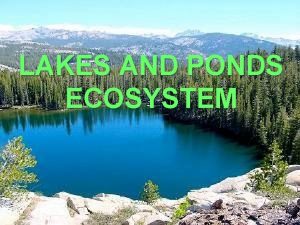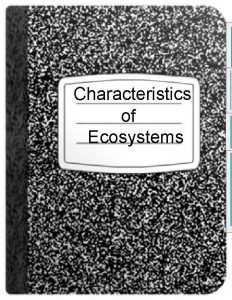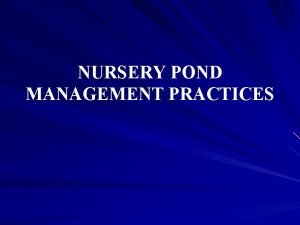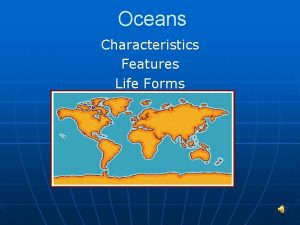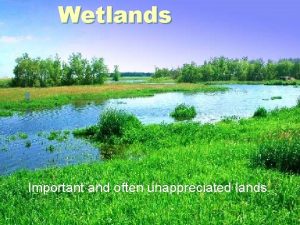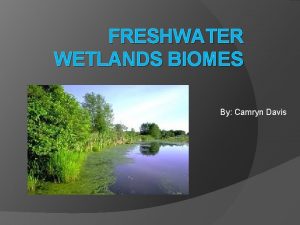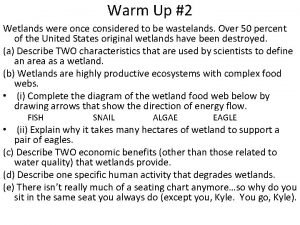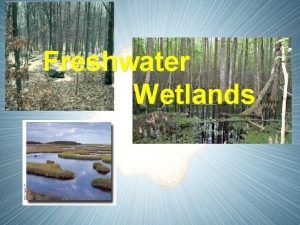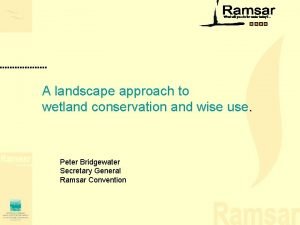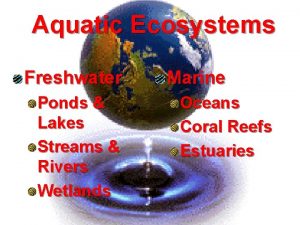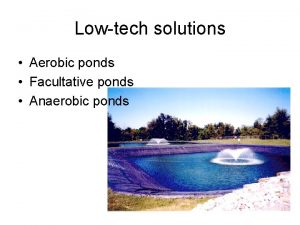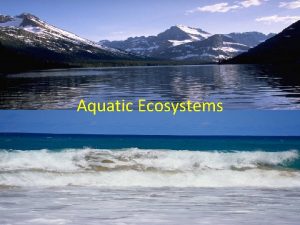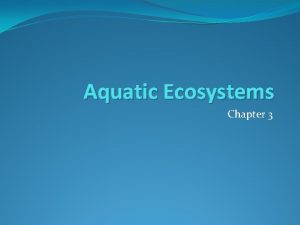Wetlands Oceans Lakes and Ponds Characteristics of Ecosystems









- Slides: 9

Wetlands Oceans Lakes and Ponds Characteristics of Ecosystems

Aquatic Ecosystems Aquatic ecosystems are water-based ecosystems. Lakes, ponds, estuaries, saltwater marshes, oceans, and thermal vents are all examples of aquatic ecosystems, but each has different characteristics. Directions: Watch the video and then complete the below sorting activity using the words on the right. Freshwater Biomes Marine (Saltwater) Biomes What is the difference between saltwater and freshwater ecosystems? A. Freshwater ecosystems don’t have plants, and saltwater ecosystems do. A. Saltwater ecosystems have a lot of salt, and freshwater ecosystems don’t. A. Animals can only live in one part of a saltwater ecosystem, but they can survive anywhere in a freshwater ecosystem. A. Freshwater ecosystems have three habitats, and saltwater ecosystems have one. Home

Estuaries are places where freshwater rivers and streams flow into the ocean, mixing with the seawater. Unfortunately, a number of challenges are threatening the health of estuaries. Estuaries provide habitats, or “homes, ” for countless fish and other wildlife. These habitats— which include coastal marshes and seagrasses—provide food, shelter, nesting, and resting areas for a broad array of animals. In addition, these habitats also filter out pollution from the water and protect the surrounding region from flooding. However, as we build more homes and businesses surrounding estuaries and pave new roads, we are destroying precious habitats and threatening the health of entire estuaries 1. Describe three ways estuaries are being destroyed? 1. Explain the characteristics of an estuary. 1. Why are estuaries so important? Activity: Drag over four pictures of plants and animals that can be found in an estuary. Home

Wetlands A wetland is an area of land that is filled or covered with water for at least part of the year. Wetlands are neither completely dry nor completely underwater. They are known as “transition zones” because they are the link between water and land, and they have a unique combination of the characteristics of both. The special characteristics of these “transition zones” enable them to support plant and animal life not found anywhere else. A common nickname for wetlands is “nurseries of life. ” 1. Explain the difference between a swamp and a marsh? 1. Describe the characteristics of wetlands. Activity: Visit the wetland mapper and click on “find a location” by entering your address to find wetlands in your area. Insert a screen clip below of the wetlands. https: //www. fws. gov/wetlands/data/Mapper. html Home

Oceans An ocean is a large body of salt water. It can be divided into three zones, or layers. The deeper the water, the colder it gets. Why? Sunlight reaches only the water near the ocean's surface. Take a look in each zone to see some of the animals that live there. Sunlit Zone (surface to 650 feet) The top layer of the ocean is called the sunlit zone. It is lit by enough sunlight for plants to grow. All plants and most marine animals live in this zone. Whales live here because they need to swim to the surface to breathe air. Some fish here have special shapes to protect them from predators. A predator is an animal that eats another animal for food. The porcupine fish puffs up and raises its spines when danger is near. Fun Fact: 70% of Earth’s surface is water! Twilight Zone (650 feet to 3, 300 feet) The ocean is colder in the twilight zone. Only dim light reaches this area. There is not enough light for plants to grow. Fewer sea creatures are found here than in the sunlit zone. Jellyfish and octopuses are often found here. Many jellyfish have stinging tentacles that they use to defend themselves and to capture prey. Prey is an animal that is caught and eaten by a predator. Octopuses use the suction cups on their tentacles to hold on to prey. Midnight Zone (3, 300 feet to 19, 800 feet) It is pitch-dark and very cold in the midnight zone. No plants grow here. Many of the animals have sharp teeth and big jaws. Other creatures, such as the ratfish, have large eyes to see in the dark. Ratfish swim along the bottom of the ocean and eat smaller sea animals, such as shrimp and sea stars. Some animals, like the hatchetfish, have body parts that glow in the dark. That helps them to attract prey. Home

Lakes & Ponds Lakes are large bodies of water that are surrounded by land. Lakes are usually freshwater ecosystems. Algae, aquatic plants, freshwater fish, amphibians, ducks, slider turtles, and beavers are some of the organisms that live in lakes. Ponds are small bodies of freshwater that are surrounded by land. Ponds are smaller and shallower than lakes, which means that the temperature of the water usually stays the same from top to bottom. Like lakes, the organisms that can be found in ponds include aquatic plants, algae, fish, amphibians, ducks, and slider turtles. Directions: Watch the Bill Nye video and then answer the questions below. 1. Explain how lakes and ponds fill up with water. 1. Explain how fertilizer from farms pollute the lakes and ponds. Home

Oceans Directions: After reading the article (previous page) about oceans, answer the below questions. 1. List the three layers of the ocean: 1. 2. 3. 1. In which layer do plants grow? Why do they only grow in this layer? Directions: After watching the video, answer the below questions. 3. Describe three causes for the “dead zones” in the oceans. 4. Explain how can we protect our oceans? Previous Page

Rivers & Streams Directions: As you watch the Bill Nye video, use the words to the right to fill in the blanks by dragging the words to the line. 1. A ____________________ is moving water. 2. Wherever there is __________________ there are living things. 3. Rivers and streams always flow ____________________. 4. Small streams are called ___________________. 5. A ______________________ is a scientist who studies rivers and water. 6. The water in rivers help support whole __________________. 7. Many plants and ____________________ depend on rivers and streams to survive. 8. People build _________________ on rivers for irrigation and electrical power. 9. When people ____________________ rivers and streams, it can ruin an entire ecosystem. 10. A lot of rivers start on the top of ____________________. Home

Let’s Review!
 Compare ponds, lakes, and stream pools.
Compare ponds, lakes, and stream pools. Characteristics of wetlands
Characteristics of wetlands Stocking management
Stocking management How does katniss surprise herself when she sees haymitch
How does katniss surprise herself when she sees haymitch Characteristics of oceans
Characteristics of oceans Why are wetlands important
Why are wetlands important Climate of freshwater wetlands
Climate of freshwater wetlands Wetlands were once considered to be wastelands
Wetlands were once considered to be wastelands Wetland ecosystem definition
Wetland ecosystem definition Conservation of wetlands
Conservation of wetlands
